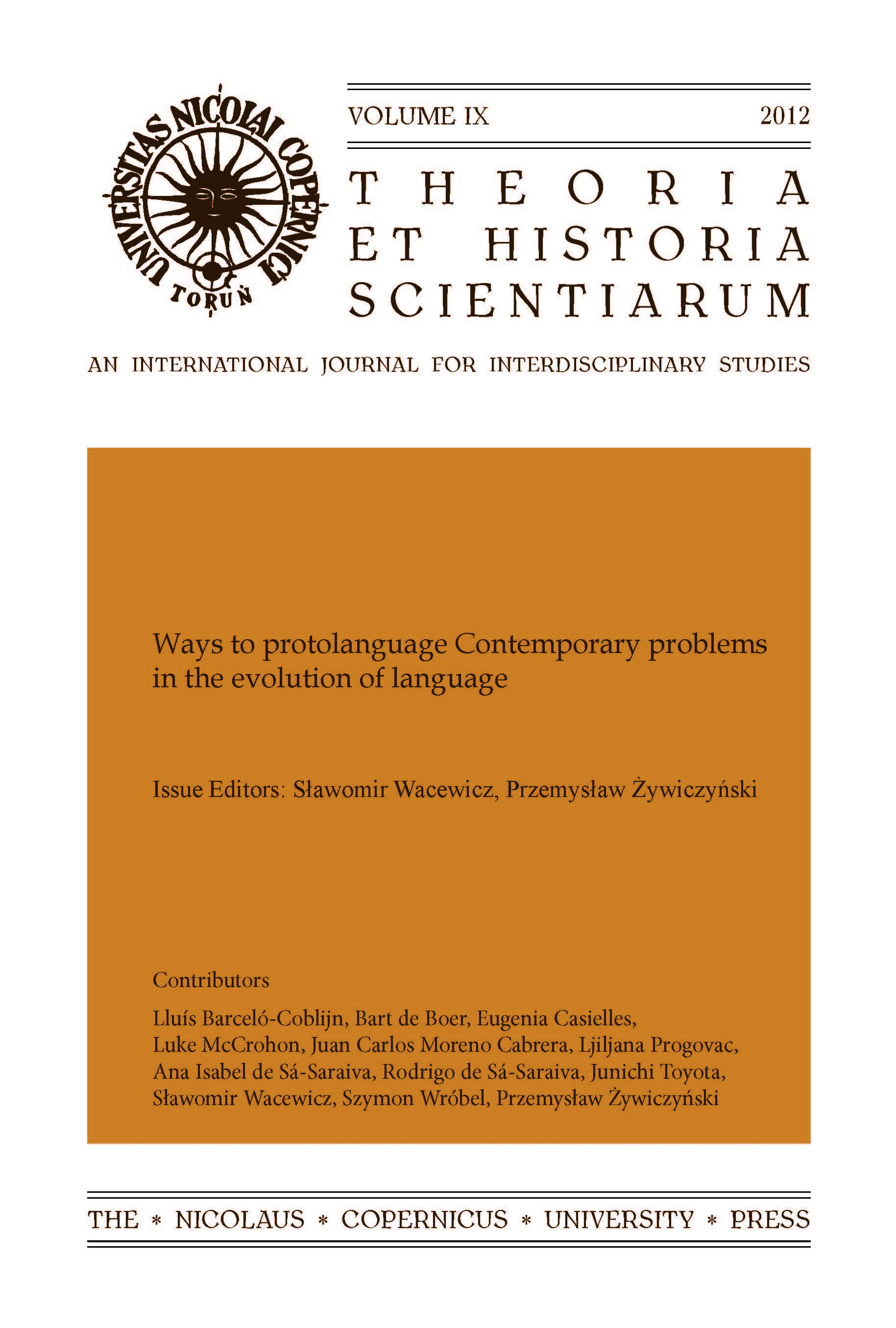On binary features in the evolution of human language
DOI:
https://doi.org/10.12775/v10235-011-0006-1Abstract
This paper has argued that the binary pair is a powerful feature in both the evolution and the recent historical change of language. It is indeed true that our language requires nouns and verbs to form predicates and to fully meet our daily communicative needs. It is easier for us to consider from our modern perspective that almost all modern languages have more than noun and verb in their lexical categories. However, it has been argued in this paper that this current state of grammar is all due to the emergence of verb. Once there is a noun-verb opposition, it is easy to develop complex grammatical systems through grammaticalisation, as schematically represented in Figure 1. The importance of binary oppositions is not restricted to evolution, but recent historical changes also suggest the importance of binary pairs, possibly recapitulating earlier evolutionary changes of languages. This line of argument would suggest that there can be two stages in linguistic evolution, i.e. the pre-binary stage and the post-binary stage. The pivotal change here is, needless to say, the emergence of verb. Grammaticalisation can easily explain how noun and verb can turn into more complex grammatical structures, i.e. the post-binary stage, but the applicability of grammaticalisation to the pre-binary stage is open to question for the moment. What is important is that our language has spent so much time to come up with the basic binary pair noun and verb, and once there is one, the rest of the development is very easy. This indicates how powerful binary pairs can be.
References
Aitchison, J. (1996). The Seeds of Speech: Language Origin and Evolution. Cambridge: Cambridge University Press.
Anderson, G. D. S. (1997). On “animacy maximization” in Fox (Mesquakie). Journal of American Linguistics, 63, 227-247.
Budge, E. A. W. (1971). Egyptian Language. London: Routledge & Kegan Paul.
Carstairs-McCarthy, A. (1999). The Origins of Complex Language: An Inquiry into the Evolutionary Beginnings of Sentence, Syllables, and Truth. Oxford: Oxford University Press.
Cheney, D. H. & Seyfarth, R. M. (1990). How Monkeys See the World. Chicago: University of Chicago Press.
Dawkins, R. (1997). Climbing Mount Improbable. London: Penguin.
Dawkins, R. (1999). Unweaving the Rainbow. London: Penguin.
Décsy, G. (1977). The Uralic Protolanguage: A Comprehensive Reconstruction. Bloomington: Eurolingua.
Deutscher, G. (2000). Syntactic Change in Akkadian: The evolution of sentential complementation. Oxford: Oxford University Press.
Donald, M. (1991). Origins of the Modern Mind: Three Stages in the Evolution of Culture and Cognition. Cambridge (MA): Harvard University Press.
Donald, M. (1993). Précis of Origins of the Modern Mind: Three Stages in the Evolution of Culture and Cognition. Behavioral and Brain Sciences 16, 737-791.
Dunbar, R. (1996). Grooming, Gossip and the Evolution of Language. London: Faber and Faber.
Fortson, B. W. IV. (2010). Indo-European Language and Culture (2nd ed.). Chichester (West Sussex): Wiley-Blackwell.
Gamkrelidze, T. V. & Ivanov, V. V. (1995). Indo-European and Indo-Europeans: A Recpnstruction and Historical Analysis of a Proto-Language and Proto-Culture (part 1): text. (English version by Johanna Nichols). Berlin: Mouton de Gruyter.
Gil, D. (2001). Creole, Complexity, and Riau Indonesian. Linguistic Typology 5, 325-371.
Givón, T. (1979). On Understanding Grammar. New York: Academic Press.
Harris, A. C. & Campbell, L. (1995). Historical Syntax in Cross-Linguistic Perspective. Cambridge: Cambridge University Press.
Heine, B. & Kuteva, T. 2002. On the evolution of grammatical forms. In A. Wray (Ed.), The Transition to Language (pp. 367-397). Oxford: Oxford University Press.
Heine, B. & Kuteva, T. (2005). Language Contact and Grammatical Change. Cambridge: Cambridge University Press.
Heine, B. & Kuteva, T. (2006). The Changing Languages of Europe. Oxford: Oxford University Press.
Heine, B. & Kuteva, T. (2007). The Genesis of Grammar. Oxford: Oxford University Press.
Hurford, J. R. (1990). Beyond the roadblock in linguistic evolution studies. Behavioral and Brain Sciences 13, 736-37.
Hurford, J. R. (2003). The neural basis of predicate-argument structure. Behavioral and Brain Sciences 26, 261-316.
Jablan, S. V. (1995). Theory of symmetry and Ornament. Belgrade: Mathematical Institute.
Lehmann, W. P. (2002). Pre-Indo-European. Journal of Indo-European Studies Monograph 41.
Lévi-Strauss, C. (1965). Le triangle culinaire. L’Arc 26, 19-29.
Lévi-Strauss, C. (1966). The Savage Mind. London: Weidenfeld and Nicolson.
Lieberman, P. (1968). Primate vocalization and human linguistic ability. Journal of the Acoustical Society of America 44, 1574-1584.
Loprieno, A. (1995). Ancient Egyptian. Cambridge: Cambridge University Press.
Lüpke, F. (2005). A Grammar of Jalonke Argument Structure. Ph.D. Dissertation, Katholieke Universiteit Nijmegen, Nijmegen.
Mallory, J. P. & Adams, D. Q. (2006). The Oxford Introduction to Proto-Indo-European and the Proto-Indo-European World. Oxford: Oxford University Press.
Newmeyer, F. (2002). Uniformitarian Assumptions and Language Evolution Research. In A.Wray (Ed.), The Transition to Language (pp. 359-375). Oxford: Oxford University Press.
Noble, W. & Davidson, I. (1996). Human Evolution, Language and Mind: A Psychological and Archaeological Inquiry. Cambridge: Cambridge University Press.
Szemerényi, O. J. L. (1996). Introduction to Indo-European Linguistics. Oxford: Clarendon Press.
Tomasello, M. (1999). The Cultural Origin of Human Cognition. Cambridge (Mass.): Harvard University Press.
Toyota, J. (2008). Aspect as a sign of historical development. Studia Romanica Tartuensia 6, 133-151.
Toyota, J. (2009a). Kaleidoscopic Grammar: Investigation into the Nature of Binarism. Newcastle upon Tyne: Cambridge Scholars Publishing.
Toyota, J. (2009b). On the evolutionary history of ‘yes’ and ‘no’. In Zlatev, J. et al. (Eds.), Studies in Language and Cognition (pp. 485-498). Newcastle upon Tyne: Cambridge Scholars Publishing.
Toyota, J. & Vlasa Florea, F. (2009). Grammatical gender: a case of neuter in Old English and languages of Europe. Facta Universitatis: linguistics and literature 7, 163-172.
Walker, A. & Shipman, P. (1996). The Wisdom of Bones: in Search of Human Origins. London: Weidenfeld & Nicholson.
Wolpert, L. (2003). Evolution of development. In K. Eichmann (Ed.), The Biology of Complex Organisms - Creation and Protection of Integrity (pp. 3-13). Basel: Birkhäauser Verlag.
Downloads
Published
How to Cite
Issue
Section
Stats
Number of views and downloads: 909
Number of citations: 0



